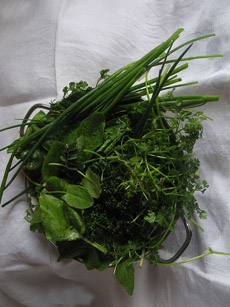TIP OF THE DAY: Use Herbs & Spices Instead Of Salt
 Salt substitute. Photo by Dirk Ingo Franke | Wikimedia. |
Recently we were lured by a heat-and-eat chicken pot pie from Trader Joe’s. The heating was easy, but the eating, not so much.
The filling was totally bland, seemingly lacking in seasoning of any kind. The label mentioned white wine, salt, white pepper, ground savory, dried parsley, ground thyme and black pepper, but the spices were indiscernable. As was the salt. Tthat chicken pot pie has 970 mg of sodium per 1 cup serving—more than half of anyone’s daily allotment—and it still tasted bland. Some people might have added even more salt. But we lifted up the crust, sprinkled ground sage and thyme onto the filling and mixed them in. It was a vast improvement—not as good as if the herbs had been baked in originally, but much better than the first bite. Here are some take-aways: |
|
|
|
||
|
WHY DON’T PRODUCTS & RECIPES USE MORE HERBS & LESS SALT?
It’s the universal answer: salt is cheaper than herbs, and most people don’t know enough to complain. In fact, the more salt people eat, the more they expect and want “saltiness.” Rule of thumb: If the salt jumps out at you and you’re not eating an intentionally salty food (pretzels or potato chips, e.g.) it’s over-salted. The salt flavor should be in the background; most foods shouldn’t taste “salty.” Prepared foods—packaged foods and meals consumed outside the home—are the worst culprits. With convenience comes salt, one thing that few people need more of. |
 Don’t reach for more salt—reach for the herbs. Photo courtesy Mrs. Dash. |
|
|
HOW MUCH SALT SHOULD YOU HAVE? Excessive dietary salt consumption over an extended period is associated with hypertension and cardiovascular disease, in addition to other adverse health effects. The American Heart Association recommends 1,500 milligrams of sodium (salt) per day*. But the average American’s salt intake is more than twice that: 3,436 mg sodium daily. A single teaspoon of salt contains approximately 2,000 mg of sodium. Even if you don’t salt your food, if you eat restaurant food or processed food—canned, prepared and frozen meals or components—you’re often consuming more salt than a deer at a salt lick. Just look at the sodium content on the nutrition labels of condiments, mixes, soups, tomato sauce and any prepared foods or meals. Single items sold by fast food restaurants can typically have 2,000 mg of sodium. And many other restaurant meals are also packed with hidden salt. No matter how young and healthy you feel now, control your salt now and you won’t have to pay the piper later—in the form of hypertension (high blood pressure) and other conditions.
|
||


